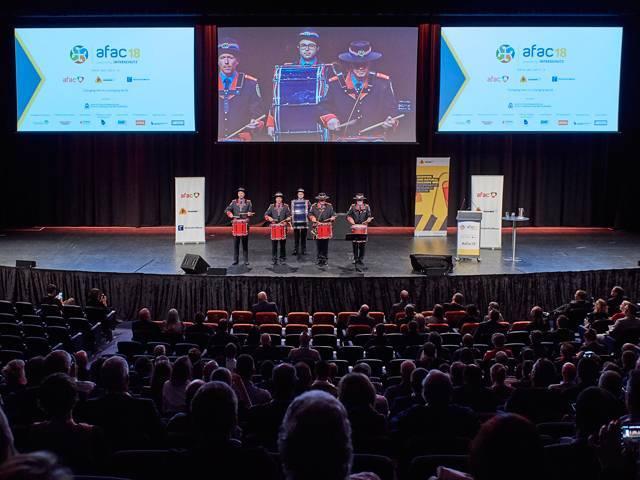Emergency Management Volunteers

The vital role emergency management volunteers play in emergency and disaster relief to be highlighted at AFAC19
Volunteers from across Australia's emergency services will drive a surge in attendance for this years' AFAC19 powered by INTERSCHUTZ conference, to be held in conjunction with the Australian Disaster Resilience Conference (ADRC) in Melbourne at the end of August.
An estimated 87 per cent of the Australian emergency management sector is made up of volunteers, with AFAC reporting that of their 296,000 members, made up of fire, SES and land management agencies, 254,000 of these members are volunteers, and 100,000 of these are based in Victoria.
The Country Fire Authority (CFA) and the Victorian State Emergency Services (SES), along with the Metropolitan Fire Brigade (MFB), Emergency Management Victoria (EMV) and the Department of Environment, Land, Water and Planning will be in attendance at the largest event of its kind to date.
In AFAC19's host state of Victoria, the CFA alone is comprised of over 60,000 volunteers, across 1,200 brigades, who provide the state with emergency services valued at $1billion annually, as well as untold millions in property, environment, and natural resources across the state. They also assist to prepare, educate and support prevention in local communities, as well as build resilience and recovery, therefore, playing a key role in protecting the state economy.
Similarly, 95 per cent of the Victorian SES is made up of volunteers, with a team of 5,000 in 149 units spread across the state.
Dr Faye Bendrups, Vice-chair, National SES Volunteers Association says, that the average age of volunteers is going up, as fewer young people are coming through the ranks to replace them.
"The average age of an emergency services volunteer firefighter is 48 years and we aren't seeing them being replaced at the rate we need. This is partly due to the perceived lack of flexibility that is offered and the changing nature of the younger workforce, with many young people on casual contracts which means they are not regularly available for training and frontline response work.
"Other reasons cited for the ageing volunteer population are potentially a lack of gender and cultural diversity in the sector, especially when compared to other non-emergency service volunteer sectors," said Dr Bendrups.
These challenges will be discussed at AFAC19, with the overall theme for the conference riding the wave of change and how the sector is transitioning to a new normal in response to factors creating significant change within communities, and the issues impacting the volunteer emergency management sector.
Local and international speakers will explore big topics including:
• Andrew McCullough & Katie Moulton NSW State Emergency Service and NSW Department of Justice,
Harnessing Community Spirit in Berowra – Redefining how NSW SES use community resources during disasters
• Jill Downard Department of Fire and Emergency Services Western Australia
Virtual Operations Support Team: harnessing corporate volunteering to create social media response surge capacity during incidents
• Jon Kneebone, Fire and Emergency New Zealand
Encourage, maintain, and strengthen the capability of volunteers
Team Rubicon Australia: Empowering Communities to Recover through the Management of Spontaneous Volunteers in Disaster Relief Operations
Stuart Ellis, CEO, AFAC said emergency management volunteers not only help in disasters but help to build more resilient communities.
"Volunteers are trained to be able to prevent, prepare for and respond to natural disasters and emergencies. They are highly skilled and are trained to provide first aid, navigation, administration, communication, incident management, support and leadership and marine rescue, as well as playing a leading role in community engagement and education, incident prevention and mitigation.
"AFAC19 is an important opportunity to bring together staff and volunteers from across the many segments of the emergency management sector, to discuss important issues specific to them and the vital role they play in crisis response and day-to-day in their local communities," said Mr Ellis.
AFAC19 will also feature the largest exhibition to date including an Expo Stage program with 30 practical presentations, and a show floor with nearly 200 companies showcasing the latest in emergency management products and services.
AFAC19 powered by INTERSHUTZ is being held at the Melbourne Convention and Exhibition Centre (MCEC) from 27-30 August 2019. The Australian Disaster Resilience Conference and the Institution of Fire Engineers Australia National Conference will be held alongside AFAC19.
Further information is available at www.afacconference.com.au
MORE





